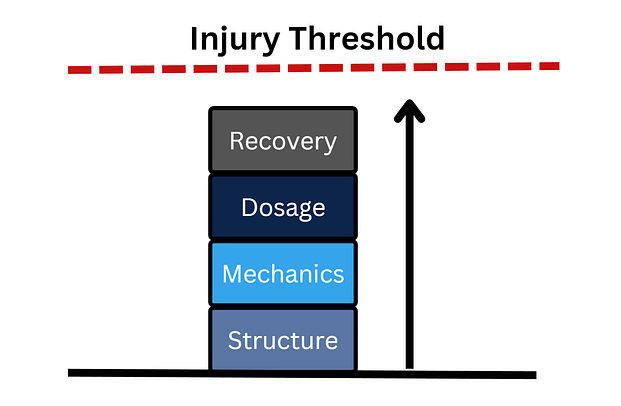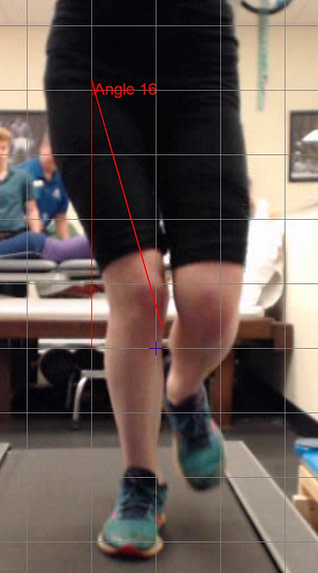Running Injuries Explained - the Holistic Picture
Runners naturally want to fix their running injuries and get back on the road as quickly as possible. Similarly, many doctors want to focus on a specific injury and move on to the next patient as quickly as possible. My previous sports medicine clinic managers would complain that I spent way too much time with each runner, but my goal has always been to figure out the root cause of running injuries and educate my runners to help prevent future overuse injuries.

Did you know that the single biggest risk factor for a running injury is a history of a previous injury? Thankfully I was able to "run" away from those quantity-obsessed managers so that I could focus on quality. Now I can spend the proper time needed to dig into my runner's risk factors, training history, strength training, & educate them on future injury prevention.
Don't Miss the Forest for the Trees
While proper diagnosis and treatment strategies will fix a particular nagging injury, learning to take a broader view can help prevent many common running injuries. I'll dig into specific running injury topics in the future, but for this introductory blog, I think we should look at the forest before staring at a tree.
After sitting through enough running medicine lectures, you start to see a pattern of overlapping risk factors for injuries as different as shin splints, IT band syndrome, and plantar fasciitis. Runners are busy people, so why not kill two birds with one stone whenever possible?
Here is a slide from a presentation I gave years ago. My job as a physician is to know the extra gritty details. But as a strength coach and running coach, I find it's much more helpful to think about the commonalities that can lead to a wide variety overuse injuries.

A simple graphic from a presentation over a decade ago by the great researcher and physical therapist, Dr. Irene Davis has helped me think about treating & preventing running injuries ever since. I hope this info can help you as well! But first, let's briefly review some of the good & bad of being a runner.
Running: A Healthy Sport!
Running is very healthy for you, duh. Lifelong runners live longer and have fewer disabilities. They have less heart disease & certain types of cancer. They even have less hip and back pain, and are LESS likely to need knee replacements than non-runners! Unfortunately, many physicians are still ignorant of these facts even as evidence continues to grow that running isn't harmful to cartilage.
But with Many (minor) Injuries!
But we also know that running injuries are very common. Studies show anywhere from 30 – 80% of runners are injured during a given year, leading to missing some training time.
I don’t deal with life-and-death situations in my practice, but the closest thing in Running Medicine is telling a runner they need to take time off. I’ve had patients try begging, bargaining, and crying to get permission to run, sometimes all in the same visit!

My mentor, Dr. Robert Wilder, looked at these injuries as initiation into the club, telling patients, “You have runner’s knee. Congratulations, you know you’re a runner now!” And the great Philosopher of Running, Dr. George Sheehan, called these running-related injuries “Diseases of Excellence.” While some look at injuries as a badge of honor, most of you probably don’t need this type of validation.
We can’t stop all running injuries, but we can take steps to lower our risk. There are four main categories contributing to our risks, and significant problems in any of these can lead to an injury. Here is graphical representation borrowed from Dr. Irene Davis:

Your injury risk is a combination of structure, mechanics, dosage, and recovery. Basically, the better you are in a box the smaller that box is; problems in a category equals a bigger box. Let’s briefly discuss each one, and then dig deeper in future posts.
Structure / Anatomy
Structure is your anatomy and possibly any major orthopedic injuries you’ve had. It mostly comes from the genetic hand you were dealt, so you can either blame or thank your parents for it.
These are things that we can’t easily change like your knee alignment, flat feet, bunions, or hip shape. For instance, retroverted hips will make your feet turn out when you walk and run. (Side note: not everyone’s feet should point straight ahead, and not every turned-out foot means overpronation!)
Some structural issues don't matter as much as we used to think they do, like flat feet, but you'll still hear about it from folks not up-to-date. Others can be improved with surgery, like ACL repair or bunionectomy. Some can be modified with orthotics and shoes, like using toe spreader devices and wide-toe boxed shoes for bunions.
Sometimes we just have to learn to work with the structure we have and focus our efforts on the other blocks. I've treated several people who came to me as a last hope before surgery. While I couldn't necessarily change the anatomical issue the surgeon wanted to treat, I could improve their running mechanics and training patterns enough so that they could get back to training without getting cut on.

This very dedicated runners had excruciating knee pain that hadn't improved with rounds of PT and other standard medical care. Her next step was surgery to fix abnormal hip alignment contributing to this problem, but with gait analysis we found that half of her knee deviation was related to muscle weakness and running form issues.
With focused exercises & gait retraining, she avoided surgery, continued running throughout high school, & even ran for a Division 1 college.
(Bio)Mechanics
Your mechanics are related to your structure but also include things that we can more easily modify.
While not everyone should move exactly the same way or have the same running form, there are commonalities we see among healthy runners and others we see in injured runners. Modifiable factors like mobility, stability, and strength all affect running form, and an ideal amount of each is needed to run well.
Biomechanics are the part of the injury equation where I’ve spent most of my career to help fix and prevent injuries. The best part of my job is that improving mechanics can not only fix injuries but also improve efficiency. Increased efficiency leads to new PRs!
Improving biomechanics and running technique is the main focus of both our PR Running classes and running gait analysis.
Dosage / Training
In this case, dosage is your training. Exercise is medicine and can be prescribed like a drug – certain types in certain dosages and frequencies, such as hill repeats x 5, one day per week. Many folks follow online plans like Couch to 5K or Runner’s World guides. Some run with local clubs or pay for coaching.

Most running and sports medicine experts believe this is the single biggest factor for determining your injury risk. Sudden changes in training are a huge risk for common injuries. This is the classic ‘Too much, too fast, too soon’ mistake.
If you have been a true couch potato for several years, going from zero running to several miles in a few weeks is not a great idea. Even experienced runners can make silly mistakes in this category.
After years of dabbling in this area, I realized it was important enough that I became a certified running coach through UESCA – United Endurance Sports Coaching Academy to better help my runners. Be sure to checkout Part 2 for more about training and training errors.
Recovery / Sleep
Is it over-training or under-recovering? I don’t really care what you call it.
Technically, this should fall under the dosage category since you should not be training any harder than your ability to recover. But people often need a reminder of that. A whole multi-million dollar recovery industry has surged in recent years despite scant evidence most of it works. I highly recommend reading Good to Go by Christie Aschwanden to hear about all the things you can save your money on.
What does work? Let's keep it simple with a few lines from her book: “Nothing else comes close to sleep’s recovery-enhancing powers. You could add together every other recovery aid ever discovered, and they wouldn’t stack up."

Injury Threshold (Oh no!)
Finally, we have the dreaded red line of the injury threshold.
Like structure, there is likely a genetic component to where this line sits for each of us. This is why some runners can follow a smart training plan, work on mechanics, and still get injured frequently, while others seem to do everything “wrong,” but rarely get injured.
I lean towards being the former type of runner which led me down this career path in the first place. Unfortunately, many of us cross the injury line several times before we start figuring out where our line sits.
Sum it Up
Hopefully, this gave you a better understanding of the global picture of running injuries. Start thinking about which building blocks are going well for you and which ones need improvement. If you have poor structure, bad mechanics, and don’t train smartly, you’ll have a tough time staying on the roads. If you were born with great structure, have wonderful mechanics, and train smartly, then I’ll see you at the finish line.
This was heavy in philosophy, but I want you to think about your training in a holistic way. If you are unfortunate enough to be in that 30 – 80% injury statistic, please find a doctor or therapist who doesn’t just look at the injured body part without asking about your training or assessing overall mechanics. Of course, I would be happy to help you as well. In the coming posts, we will dive a little deeper into training and biomechanics to minimize injury risk and keep you running.
Thanks and Happy Running!
Kasey Hill, MD
Disclaimer
This website provides information only, and does not provide any financial, legal, medical or psychological services or advice. None of the content on this website prevents, cures or treats any mental or medical condition. You are responsible for your own physical, mental and emotional well-being, decisions, choices, actions and results. PR MD Running disclaims any liability for your reliance on any opinions or advice contained in this website. Kasey Hill MD is a medical doctor & running coach, but he is not your doctor or coach unless you become his patient or client by booking a medical or coaching consult, and he is not offering medical advice on this website. If you are in need of professional advice or medical care, you must seek out the services of your own doctor or health care professional.

